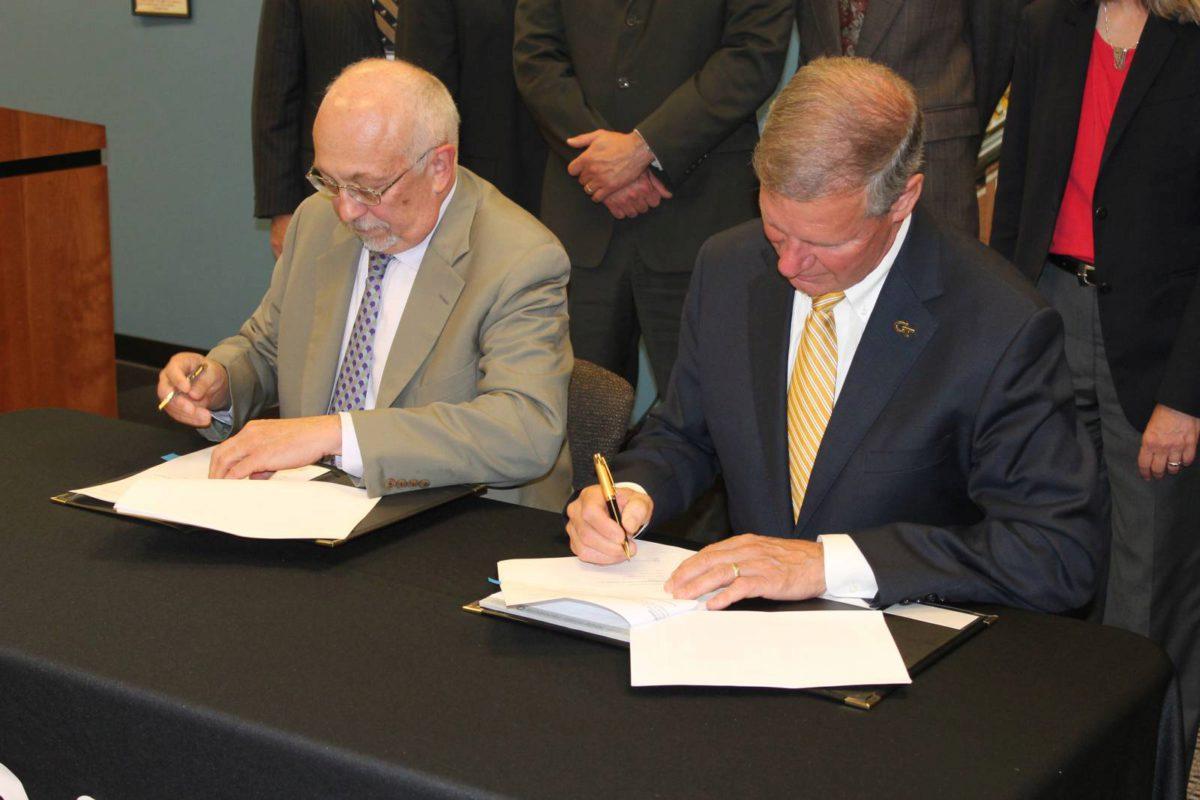
ATLANTA — Sandia National Laboratories and the Georgia Institute of Technology have signed a five-year memorandum of understanding (MOU), establishing a strategic collaboration that seeks to solve science and technology problems of national importance.
Sandia President and Laboratories Director Paul Hommert and Georgia Tech President G. P. “Bud” Peterson signed the document at the Centergy Building on the Georgia Tech campus.
The MOU has three principal goals: solve major national problems, engage talented researchers to work on practical, complex problems early in their academic careers and introduce new ideas and technologies into the marketplace through jointly developed intellectual property. MOUs such as this one seek to build strong ties between major national research universities and federally funded research and development centers, such as Sandia.
“We will build on the existing strong relationship between Georgia Tech and Sandia. The MOU brings together one of the outstanding engineering programs in the nation and one of the most accomplished engineering laboratories in the world,” Hommert said. “Our goal is to foster an environment that advances innovation and impactful technical solutions.”
Peterson added, “This MOU furthers Georgia Tech’s research strategy, which is focused on the pursuit of transformative research, strengthening collaborative relationships and maximizing the economic and societal impact of our research.”
Jill Hruby, Sandia vice president for Energy, Nonproliferation & High-Consequence Security, has developed many of the current collaborative programs with Georgia Tech. “It is exciting to see the long-term collaboration between Georgia Tech and Sandia move to an even higher level,” Hruby said. “I’m confident the common culture and research interests at our institutions combined with the focus that comes from this MOU, will produce innovative solutions and high quality research.”
Among the technical frontiers of common interest to Sandia and Georgia Tech researchers are energy and grid security, advanced manufacturing, computer science and data analytics, microsystems and sensors, cybersecurity and materials science.
Sandia and Georgia Tech have been collaborating for many years, most recently in computer science and advanced computer architectures, energy systems, manufacturing and materials science. Many Georgia Tech students and faculty spend time at Sandia, while Sandia counts many Georgia Tech graduates among its staff members.
Georgia Tech has 12 core research areas, many of which correspond to some of the major research foundations and mission areas of Sandia National Labs.
The MOU will provide opportunities for students and faculty to experience research work at a national lab; enable joint recruiting of top graduate students, postdoctoral fellows and faculty; increase transfer of technology from Sandia and the university to the private and federal sectors; and build collaborations that address nationally significant problems.
Both institutions will take multidisciplinary approaches to solving national problems and developing new technologies. Georgia Tech is known for its ability to break down traditional academic barriers and assemble interdisciplinary teams, while Sandia’s scientific research and systems engineering approach form the foundation for the labs’ seven decades of contributions to national security.
Opportunities for joint faculty appointments and for research sabbaticals are expected to enhance collaborations further, Hommert and Peterson said.
Sandia President and Laboratories Director Paul Hommert (l) and Georgia Tech President G. P. “Bud” Peterson (r).
Sandia National Laboratories is a multi-program laboratory operated by Sandia Corporation, a wholly owned subsidiary of Lockheed Martin Corp., for the U.S. Department of Energy’s National Nuclear Security Administration. With main facilities in Albuquerque, N.M., and Livermore, Calif., Sandia has major R&D responsibilities in national security, energy and environmental technologies and economic competitiveness.
The Georgia Institute of Technology, also known as Georgia Tech, is one of the nation’s leading research universities, providing a focused, technologically based education to more than 21,500 undergraduate and graduate students. Georgia Tech has many nationally recognized programs, all top-ranked by peers and publications alike, and is ranked in the nation’s top 10 public universities by U.S. News and World Report. It offers degrees through the Colleges of Architecture, Computing, Engineering, Sciences, the Scheller College of Business, and the Ivan Allen College of Liberal Arts. As a leading technological university, Georgia Tech has more than 100 centers focused on interdisciplinary research that consistently contribute vital research and innovation to American government, industry, and business.
Sandia news media contact: Jim Danneskiold, jddanne@sandia.gov, (505) 844-0587
